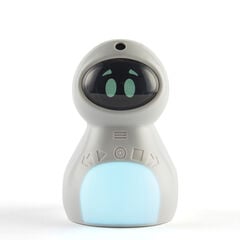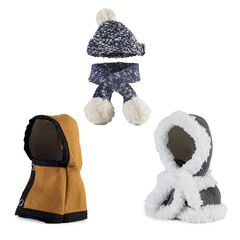Kitt robot is a friendly learning companion with characteristics designed to capture children’s attention. Choosing an engaging strategy to introduce Kitt will harness children’s natural curiosity and help to ensure that Kitt serves as a valuable and purposeful learning tool in the classroom.
What is Kitt Robot?
Kitt is an interactive and engaging robot designed for children to use to support their learning and emotional needs. It features a built-in camera, video recorder, and voice recorder, making it versatile for use in classrooms, wider school environments, and home-school connections. Kitt is tactile; it vibrates, lights up, and produces sounds when touched or moved. Its child-like voice enables children to relate to it, allowing attachments to be formed. This makes Kitt effective as both a learning companion and well-being companion, serving as a valuable tool for teachers.
As every child and classroom of children is unique, this blog will explore several strategies you can use to introduce children to Kitt.
Considerations Before Introducing Kitt
Before introducing Kitt to your class, think about how you plan to utilise Kitt in your classroom or school. The way you choose to implement Kitt will influence how you introduce it to children.
Here are several ways you may choose to utilise Kitt:
- Whole Classroom Tool: Incorporate Kitt into all subjects so it is regarded as a regularly available resource for enhancing learning.
- Learning Companion: Use Kitt to support the learning of an individual child or group of children during lessons.
- All-Day Companion: Use Kitt to support an individual child or group of children throughout the whole day, including transitions and break times.
- Wellbeing Companion: Offer Kitt as a supporting companion for children who may need additional emotional or mental health support.
- SEND Companion: Use Kitt as a specific tool for supporting SEND children.
- Intervention Tool: Use Kitt as a specific tool for targeted interventions.
- Home-School Link: Send Kitt home with children as a learning companion to reinforce skills outside the classroom and so children can share interests and experiences outside of school.
- Multi-Purpose Tool: Combine all the above uses for a versatile approach that serves whole-class, individual and group needs.
Strategies for Introducing Kitt to the Whole Class, Small Group of Children or an Individual Child
The following ideas are written from introducing Kitt to a whole class perspective, but can easily be adapted for introducing Kitt to a single child or small group of children.
The Mystery Visitor
Something unexpected suddenly appearing in a classroom can generate a lot of curiosity amongst children and can instantly become a talking point. Here are two examples of how you might use the mystery visitor concept to introduce Kitt to both younger and older children.
For younger children:
- Place Kitt in a decorated box and discuss what might be inside.
- Take Kitt out of the box or choose a child to do it. Discuss what Kitt might be and how it might work.
- You may wish to give Kitt a name tag or a special letter explaining how it works inside the box.
- Gather the children’s ideas then show the children what Kitt can do.
- Demonstrate how Kitt works and some of its functions. Can the children now think of some ways Kitt might help them in school?
- Explain how Kitt will be used in school, where it will be used and who will be using it.
- Complete an activity together to demonstrate how Kitt can be used. This could be recording a whole class reading session, taking photographs of scientific experiments or recording some moves in P.E. to review and improve.
- If you have multiple Kitts, place Kitt in its box on each table (you may wish to wrap the box for an extra element of surprise). Allow time for the children to unbox Kitt and play with its buttons to see how it works.
For older children:
To spark curiosity, place Kitt somewhere prominent in the classroom where children will be able to see it as they enter the classroom. If you have multiple Kitts, place Kitt in his box on each table and let children open up the box.
- Ask the children what they think Kitt is. Most older children will probably recognise that Kitt is a robot.
- Ask the children what they think Kitt will do and how it might be used. You might wish to pass Kitt around the class at this point so children can look at Kitt more closely. If you have multiple Kitts, allow time for the children to explore Kitt’s functions then share ideas.
- After sharing the children’s ideas, demonstrate how Kitt works. You may wish to use our ‘Kitt Adaptable Branded PowerPoint‘ to support your demonstration.
- Explain how Kitt will be used in school, where it will be used and who will be using it.
- Next, provide activities for the children to complete using Kitt. For example, writing a joint short piece of writing with a partner, taking a photograph of their work and recording themselves reading it out. Or recording a video of a science experiment or musical performance. Can they remember how to view their photographs/videos? Or how to delete unwanted recordings?
People and Things that Help Us
If introducing to younger children, focus around the topic of ‘People Who Help Us’.
- Start by discussing people who help us, such as doctors, teacher and the police.
- Then discuss how machines/robots can also help us, such as tablets, washing machines, microwaves, thermostats etc.
- Show the children Kitt and explain that he is a robot/learning companion who is going to help us in the classroom. Explain how Kitt will help, when it will be used and who will use it.
- Demonstrate how Kitt works, using the ‘Kitt Adaptable Branded PowerPoint‘ to help support the demonstration.
- Plan a whole class activity which involves using Kitt to help complete a task. Or, if you have multiple Kitts, allow time for children to explore Kitt’s functions.
- When children have had time to explore Kitt and understand how it works, ask the children to create a Kitt poster to show how Kitt will help them with their learning.
Slow and Steady Wins the Race
If introducing all Kitt’s functions at one time may be too stimulating for your class or too much information to process, take a steadier approach. This can be achieved through devising a scheme of lessons/activities to support a slow introduction of Kitt.
Here is an example of a scaffolded approach which you may choose to do over a number of days or weeks:
1: Introduce Kitt as a robot and discuss other robots that people use in everyday life – at home, school and in the wider world.
2: Put Kitt into ‘Play Mode’ and allow time for the children to simply play with Kitt so they have time to become familiar with how Kitt feels and looks etc.
3: Show and demonstrate Kitt’s timer then set the children some timed tasks to do, using Kitt as a timer. If you have multiple Kitts, set children the challenge of setting the timer themselves. Use Kitt as just a timer for as long as the children need to get used to it and respond to it.
4: Show and demonstrate Kitt’s camera. Plan a task where children need to take photographs using Kitt. Review the children’s photographs by uploading them onto the computer.
5: Show and demonstrate Kitt’s video recorder. Plan a task where the children need to take videos. Review the children’s videos by uploading them onto the computer.
6: Show and demonstrate Kitt’s voice recorder. Plan a task where children need to make a voice recording. Review the children’s voice recordings by uploading them onto the computer.
7: Once children are familiar and comfortable with all Kitt’s functions, regularly use Kitt as a multi-functional tool so children retain how to use and interact with it.
Taking a steadier approach also allows more time to gauge how children respond to certain features. Some children may prefer Kitt not to make sounds, for example, or vibrate when touched. These setting can be easily altered to suit the needs of your class.
Kitt Robot at Home
Allowing children to take Kitt home is a great opportunity for providing each individual child with personal time to explore Kitt’s functions. It’s also an excellent opportunity for creating a home-school link and for allowing parents/guardians to become familiar with Kitt.
Here are some suggested steps for sending Kitt home with a child:
- Briefly introduce Kitt robot and explain that each child will take it in turns to take Kitt home to get to know it. You may wish to pull names out of a hat to decide who gets to take Kitt home first.
- Decide how long each child gets to take Kitt home for.
- Provide each child with a guide or letter explaining how Kitt works. This is useful for both the child and the child’s parents/guardians.
- To keep Kit extra safe, place Kitt in a Kitt Dry-Bag ready for transportation and provide children with a Kitt ‘Cleaning and Transport Guide’.
- Set a challenge for the children to complete using Kitt at home.
Example Challenges Children Could do at Home with Kitt
- Record themselves reading a story or singing a song to Kitt.
- Take photographs of family members.
- Take a picture of things from nature.
- Take a video or pictures of a favourite hobby.
- Design a bed or clothing for Kitt and then take pictures of their designs to share with the class.
Why not design a tag for Kitt to wear when he goes to a child’s home? For example, the tag could read, ‘Hi. My name is Kitt. I am a fun learning companion. Please take good care of me.’
Making Kitt Welcome – Further Activities for Helping Children Become Familiar with Kitt
Design a Kitt Poster
Here are some ideas for themes:
- Rules for looking after Kitt.
- A poster showing how Kitt works.
- A poster explaining how Kitt helps the class.
- A poster with Kitt introducing itself and welcoming people to the class.
Personalise Kitt

Why not personalise Kitt with his own clothes and accessories?
There are ready made Kitt clothes available on the TTS website. Decide as a class when Kitt will wear the clothes and what each outfit means. Should Kitt wear clothes when being used outside? For certain subjects? When working with an individual child?
Why not even design your own clothes for Kitt? it could form part of a DT project or be a competition. Kitt could have different outfits for different subjects. A special coat that it wears when it goes to a child’s home. Maybe he should have pyjamas for when he stays at a child’s house? Could Kitt even have his very own school uniform made so he becomes a true member of the class?
Children could also design a home for Kitt where he lives in the classroom. Or a bed that he’s placed in at the end of the school day.
Make a Song and Dance About Kitt
Create a song or dance about Kitt which focusses on him being a friendly robot who helps others. Record and playback the song or video using Kitt. Perhaps the song or dance could be used to introduce Kitt to other children?
Create a Story or Poem About Kitt Robot
Ask children to write a story about Kitt or create a whole class story. Perhaps Kitt could go on an adventure where all its functions help it save the day or have fun. Or maybe children could write a recount of when Kitt first came to school, the people Kitt met and places it visited in the school. There are lots of possibilities.
Ask children to create a poem about how friendly Kitt is and how Kitt helps with learning. Or maybe a poem about when Kitt came to school.
Take Kitt on a School Tour
Invite children to take Kitt robot on a school tour to introduce Kitt to people and show Kitt all the different parts of the school. Children can record the tour on Kitt itself and use the recording to help them write a recount of Kitt’s school tour from Kitt’s point of view.
Conclusion
Thoughtfully considering the best strategy for introducing Kitt to children will enhance their engagement and understanding of how to utilise Kitt. Additionally, by ensuring that Kitt is always visible and accessible, educators can provide a consistent learning companion that supports both individual and collaborative learning experiences.
To see Kitt being introduced to a class and to listen to school practitioners talk about the many ways that they have used Kitt in school, watch our ‘Terrific Testing Squad: Kitt, The Learning Companion ‘ video.
Written by Kelly Lawrence.
Kelly has 15 years of experience working as a Primary School Teacher in both Key Stage 1 and 2.
















